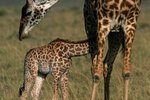
Though animals like elephants, bears and gorillas are certainly strong animals, they have much less strength relative to their body size than many more meager creatures. Ants and beetles may only lift paperclips and food crumbs, but relative to their body size, these critters are capable of herculean tasks.
Smaller Animals are Stronger
All things being equal, an animal’s relative strength for its mass will go down as the animal’s size increases. In other words, a 100-pound animal will be stronger relative to its body weight, than a 200-pound version of the same animal. This is because strength increases in proportion to the surface area of a muscle’s cross section, while the muscle’s mass is based primarily on volume, which increases much more quickly than the cross section of muscle does. Of course, small animals can’t lift as much absolute weight as larger animals can, but proportionally to their size, small animals are much stronger.
Ants
Anyone who has ever watched a line of ants robbing a picnic knows that ants are clearly strong animals. It isn’t rare to see an ant carrying a piece of food that is larger than its body. Weaver ants are able to hold 100 times their body weight while hanging upside down. Even more impressively, the appropriately named Odantomachus ants have incredibly strong jaw muscles and can shut them at 143 miles per hour. In doing so, these ants create forces 500 times the mass of their body.
Rhinoceros Beetles
Rhinoceros beetles have been hailed as some of the strongest animals in the world, relative to their size. Able to carry 850 times their own weight, male rhinoceros beetles are equipped with large horns on their heads that are used to combat with other male beetles. Rhinoceros beetles are herbivores that are harmless to humans.
Dung Beetles
In 2010, Robert Knell, et al., crowned a new strength champion: the dung beetle (Onthophagus taurus). Publishing their results in “Proceedings of the Royal Academy B,” the researchers documented the species dragging over 1,100 times their body weight behind them. This species of dung beetle is native to Europe and the Middle East, but has been introduced to the eastern United States. This species has an interesting reproductive biology; two types of males exist: “major” and “sneaker” males. Major males are large and strong and engage in brutal territorial wrestling matches for access to females, whereas the “sneaker” males seek to avoid the larger males entirely. Scientists are still not sure whether the different male types arise due to genetic or environmental causes.
Chimpanzees
Glen Fitch, of the Yale Primate Laboratory, tested the strength of chimpanzees in 1943. He used a device that tested the pulling strength of chimpanzees and strong humans, and compared the results. Interestingly, despite persistent myths that chimpanzees are five to eight times stronger than humans, the chimpanzees were only able to pull a similar weight as humans. However, chimpanzees are slightly smaller animals than humans are; large adult chimpanzees stand 5 feet tall and weigh 150 pounds. Once the measurements were corrected for relative size, chimpanzees were shown to have about twice the strength of humans, relative to their body weight.
References
Photo Credits
-
Visage/Stockbyte/Getty Images




